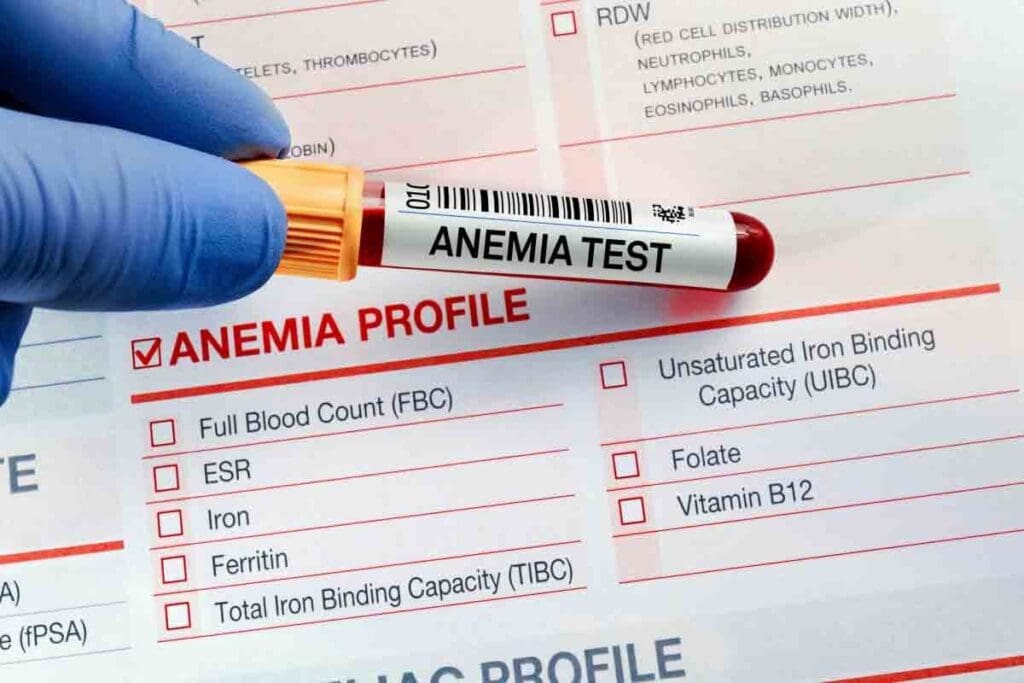Last Updated on November 17, 2025 by Ugurkan Demir

Iron deficiency is a major global health issue, affecting millions of people every year. Early detection and treatment are crucial to prevent serious complications. Thanks to modern technology, anemia test at home kits are now more accessible, allowing users to monitor iron levels easily and accurately.
The CDC estimates that approximately three million people in the U.S. are living with anemia. At-home testing kits like the Cerascreen Ferritin Test and LetsGetChecked Iron Test make it simple to check your iron levels without visiting a clinic. These kits typically measure ferritin—the protein that stores iron in your body—and provide clear, easy-to-understand results within days.
Understanding your results is the first step toward proper management. If your test shows low iron, follow up with a healthcare professional to discuss treatment options. For more information on iron testing and how to perform an anemia test at home, explore medically reviewed resources or speak with your doctor for guidance.

It’s important to know about anemia and iron deficiency early. These conditions can really affect your health. Anemia happens when your body doesn’t have enough red blood cells. This is often because of not enough iron.
Iron deficiency can show in many ways. Some signs might not seem related to anemia at first. Look out for:
These symptoms can really change your daily life. Knowing them is key. As the Medical News Today article on at-home iron tests says, being aware can lead you to get tested.
Testing iron levels is key for diagnosing and treating anemia and iron deficiency. It helps doctors find the cause of your symptoms. Early detection with iron deficiency test kits can stop problems and improve health.
“Iron deficiency is a significant public health problem worldwide, and its diagnosis requires a combination of clinical evaluation and laboratory tests.”
Source: A medical professional’s statement on iron deficiency.
Some people are more likely to get anemia. These include:
| Risk Factor | Description |
| Menstruation | Women with heavy or prolonged menstrual periods are at increased risk. |
| Pregnancy | The demand for iron increases during pregnancy, making pregnant women more susceptible. |
| Diet | A diet lacking in iron-rich foods can lead to deficiency over time. |
| Chronic Diseases | Conditions like celiac disease or gastrointestinal disorders can impair iron absorption. |
Knowing these risk factors can help you prevent anemia. Using a home test for iron in blood is a good first step to check your levels.

At-home anemia testing kits vary in form, each with its own benefits and limits. They cater to different needs, from detailed analysis to quick checks. This variety helps individuals pick the best test for them.
Comprehensive iron panel tests give a detailed look at your iron levels. They measure serum iron, ferritin, and sometimes total iron-binding capacity (TIBC). These tests help diagnose iron deficiency and related conditions.
Benefits: They offer a full view of your iron status.
Limitations: They might cost more than simpler tests and require understanding the results.
Ferritin-only test kits focus on ferritin levels, showing your body’s iron stores. Low ferritin is a key sign of iron deficiency. These tests are great for catching anemia early.
Hemoglobin tests are another common at-home anemia test. They measure hemoglobin levels in the blood. Low levels can indicate anemia. While not as detailed as iron panels, they offer a quick anemia check.
It’s important to remember that hemoglobin tests can’t tell you the cause of anemia.
When picking an at-home anemia test kit, consider cost and the information you need. Whether it’s a detailed iron panel or a simple hemoglobin test, knowing your iron levels is key to managing your health.
At-home iron tests measure key components to show your iron status. These tests help you understand your iron levels. They can spot iron deficiency or anemia.
Ferritin stores iron in your body. Its blood level shows your iron stores. A ferritin test at home checks if you have low iron. Low ferritin means you might have iron deficiency anemia.
Serum iron shows the iron in your blood. Transferrin saturation shows how much iron is being carried. These are key to seeing if your body can move iron where it’s needed.
Hemoglobin carries oxygen in red blood cells. A hemoglobin test, often in a CBC, can spot anemia. At-home hemoglobin tests give quick insights into your oxygen-carrying ability.
TIBC shows how well your body can bind and transport iron. A high TIBC might mean you’re low on iron. Your body makes more transferrin to grab any iron it can.
Knowing what each test measures helps you understand your iron status. This knowledge lets you take steps to improve your health.
Understanding these indicators gives you insights into your iron status and health. At-home iron tests are a handy way to keep an eye on your iron levels. They help you stay proactive about your health.
Choosing the right at-home anemia test is important. You need to think about your health needs and what the test offers.
Start by thinking about your health concerns. Do you feel tired, weak, or have trouble breathing? Knowing this helps pick the right test.
If iron levels are your worry, look for a test that checks ferritin. For a full check, consider a test that looks at hemoglobin, serum iron, and more.
Not all tests are the same. It’s key to find tests that are accurate and reliable. Look for ones that have been proven to work well.
| Test Type | Accuracy | Reliability |
| Ferritin Test | High | Clinically validated |
| Hemoglobin Test | Moderate | Generally reliable |
| Comprehensive Iron Panel | High | Highly reliable |
Cost matters too. Prices vary by test and provider. Check if your insurance covers these tests.
Think about the cost per test. Some tests might cost more but give more info, saving you money later.
The best test balances your health needs, budget, and what you prefer. Look at accuracy and cost to make a good choice.
Always talk to a doctor before using at-home test results. They can help understand your results and what to do next.
To get reliable results, it’s key to prepare well for your home iron test. Good preparation can make your test results more accurate.
The time you choose for your test matters. It’s best to test in the morning before eating. This is because iron levels change during the day. Testing in the morning gives a clearer baseline.
Your diet can affect your iron levels. For the best results, don’t eat foods high in iron or take iron supplements before testing. A study shows that what you eat can greatly impact your iron levels as noted in this research.
Some medicines can change your iron levels and test results. This includes iron supplements, vitamin C, and some antibiotics. Always tell your doctor about any medicines you’re taking before the test.
Make sure you have everything you need for your home iron test. This includes the test kit, lancets, and any other items in the kit. Having everything ready will make the process easier.
| Preparation Step | Description |
| Optimal Timing | Test in the morning before breakfast |
| Dietary Considerations | Avoid iron-rich foods and supplements before testing |
| Medications | Inform your healthcare provider about any medications you’re taking |
| Gathering Supplies | Ensure you have all necessary materials from the test kit |
To get reliable results from your at-home iron blood test, follow our step-by-step guide. Collecting a blood sample for an at home iron blood test or iron level test kit needs careful attention. This ensures accuracy in your results.
Before starting, sanitize your workspace to avoid contamination. Wash your hands with soap and warm water, then dry them with a clean towel. Make sure your testing area is clean and dry. Place all the items from your home iron blood test kit within reach.
Use the lancet from your test for anaemia at home kit to prick your fingertip. This spot is less painful because it has fewer nerve endings. Hold the lancet at a 90-degree angle and press the trigger. Then, gently massage your finger to help the blood flow.
The next step is to collect the right amount of blood. Follow the instructions in your kit, as the amount needed may vary. If using a collection tube, fill it to the line shown. For test strips, make sure the sample area is fully saturated.
Several mistakes can ruin your blood sample. Don’t squeeze your finger too hard, as it can damage the red blood cells. Also, avoid touching the test strip or collection tube with your fingers, as your skin oils can contaminate the sample. If you see air bubbles or clots in the sample, you might need to collect more blood.
By following these steps carefully, you can collect a good blood sample. This will give you accurate results from your at home iron blood test or iron level test kit. If you have trouble, check the kit’s instructions or contact the manufacturer’s support for help.
The last step in testing for iron at home is sending your blood sample to a lab. This step is key to getting your test results right. It makes sure your sample is handled correctly.
Most test kits, like those for home test for iron in blood, have clear packaging instructions. You’ll need to put your blood sample in a special container. It’s important to follow these steps to avoid damaging your sample.
Always check the packaging for any special needs, like refrigeration. Proper packaging is vital for accurate test results.
Test kits usually come with pre-paid shipping labels. This makes sending your sample easy. Make sure to check the shipping details, like the deadline and the carrier.
For an iron deficiency test home kit, you have 24 to 48 hours to send it. Tracking your shipment is a good idea to ensure it arrives on time.
After shipping, you can track your sample with the tracking number. This lets you see when it reaches the lab.
The time it takes to get your check iron at home test results varies. But usually, it’s 3 to 7 business days after the lab gets your sample. We’ll show you how to get your results online or by mail.
By following these steps and your kit’s instructions, you can send your sample to the lab correctly. This way, you’ll get your test results quickly and accurately.
After taking your at-home iron test, it’s important to understand your results. They can tell you a lot about your iron levels. This helps you see if you might have a deficiency or other health issues.
Iron test results have normal ranges, but these can differ slightly. For ferritin tests, a level between 30-400 µg/L is usually normal. But, levels under 30 µg/L might show iron deficiency. Always talk to your doctor to know the exact ranges for your test.
Ferritin levels are key to knowing your iron stores. Low ferritin means you might have iron deficiency, even without anemia symptoms.
Levels under 30 µg/L mean your iron stores are low. This can cause iron deficiency anemia if not treated. Low ferritin can come from not getting enough iron, losing blood, or needing more iron due to pregnancy or illness.
Hemoglobin (Hb) levels are also important in iron tests. Low Hb means you might have anemia. Other tests like serum iron, transferrin saturation, and Total Iron-Binding Capacity (TIBC) give a full view of your iron health. Knowing all these can help find the reason for iron deficiency or anemia.
A complete iron panel includes ferritin, serum iron, transferrin saturation, TIBC, and sometimes hemoglobin. Looking at all these together gives a detailed picture of your iron health. For example, low ferritin with low serum iron and high TIBC might show iron deficiency anemia.
It’s best to talk to a healthcare provider to understand your results. They can help you figure out what to do next based on your situation.
After using an at-home kit to test your iron levels, it’s important to understand your results. Knowing when to see a doctor is key. Your test can show your iron levels, but it’s up to you to know what it means.
If your test shows low ferritin or hemoglobin, see a doctor. These signs might mean you have iron deficiency or anemia. Both need a doctor’s care and treatment.
Also, if you feel tired, weak, or have trouble breathing, get medical help. These signs could mean you have a health problem that needs a doctor’s check-up.
At-home iron tests are useful, but they’re not perfect. They can’t tell the whole story of your health. A doctor can look at your whole health picture, including your medical history and symptoms.
Your doctor might want you to have more tests after your first results. This could be to check your iron levels more closely or to find out why you’re low. For example, if your iron is low, they might want to do more tests to find the reason.
| Test Type | Follow-up Recommendations |
| Ferritin Test | If low, consider a more detailed iron test or CBC |
| Hemoglobin Test | If it’s off, you might need a CBC and iron panel |
| Comprehensive Iron Panel | More tests might be needed based on what you find |
When talking to your doctor about your test results, be ready. Bring your test results, any symptoms you have, and any questions. This helps your doctor understand your situation better and give you the right advice.
You might ask your doctor to explain your results in the context of your health. Or ask about treatment options if you have iron deficiency or another issue.
At-home anemia tests are a handy way to check for iron deficiency. They help you understand your iron levels. This way, you can spot any issues and talk to doctors about them.
With an anemia test at home or at home iron test, you can check your iron levels easily. Tests like a home test for iron in blood or an iron level test kit give you important info. They show how much iron your body has, helping you make better health choices.
We suggest starting to learn about your iron levels and health. Using at-home tests and getting advice from experts can help you manage your health well. This way, you can catch and fix any problems early.
An at-home anemia test is a kit for checking iron levels and anemia at home. It involves a finger prick to collect blood. This blood is then sent to a lab for analysis.
You can find different at-home anemia test kits. These include tests for iron levels, ferritin, and hemoglobin. Each test looks at different aspects of iron and anemia.
Choose based on your health concerns, the test’s accuracy, and your budget. Also, check if your insurance covers it.
At-home iron tests measure ferritin, serum iron, and more. They look at different parts of iron levels and anemia.
Prepare by timing your test right and avoiding certain foods. Also, consider any medications that might affect the results. Make sure you have all the needed supplies.
To collect blood, clean the area first. Use the right finger-pricking technique. Make sure to get enough blood and avoid mistakes.
Send your sample by following the kit’s packaging and shipping instructions. You can track your sample and get updates on processing time.
Understand normal values and what low ferritin means. Also, know how to read hemoglobin and other measurements. You might need a doctor’s help to fully understand your results.
See a doctor if your results worry you or if you’re unsure about them. Discuss your results with your doctor to figure out what to do next.
Insurance coverage for at-home anemia tests varies. Check with your insurance to see if they cover the test you’re interested in.
Yes, you can use an at-home anemia test even if you’re taking iron supplements. Just tell your doctor about your supplements, as they might affect the test results.
At-home anemia tests can be accurate if done right and the lab analysis is reliable. But, accuracy can vary based on the test type and kit quality.
Subscribe to our e-newsletter to stay informed about the latest innovations in the world of health and exclusive offers!